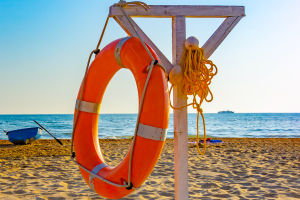Swim Safety Tips
Swimming is not only a popular sport but also a vital life skill, offering numerous physical and mental benefits.
However, despite its widespread appeal, swimming poses inherent risks that demand a thorough understanding of safety measures to mitigate potential dangers. Here are comprehensive guidelines to ensure safe swimming practices:
1. Environmental Awareness:
When engaging in water activities, whether at pools, beaches, or natural water bodies, always assess the surroundings for potential hazards. Be mindful of underwater obstacles, currents, and changes in water depth, especially in unfamiliar locations.2. Swimming Preparations:
Before entering the water, engage in warm-up exercises to prepare your muscles and prevent injuries. Additionally, gradually acclimate your body to the water temperature by splashing cold water on your limbs. Avoid swimming on a full stomach or when fatigued, as it can compromise your ability to swim safely.3. Water Plant Awareness:
While swimming, be vigilant for aquatic vegetation, which can entangle swimmers and pose risks. If you encounter water plants, immediately cease stroking and transition to a backstroke position to move away from the area. In the event of entanglement, remain calm, float on your back, and carefully extricate yourself from the vegetation.4. Understanding Tides and Currents:
At coastal areas, educate yourself about tidal patterns and currents, as they can significantly impact water safety. Be cautious during rising tides, as they can lead to stronger currents and potentially dangerous conditions near shorelines.5. Cramp Management:
Cramps can occur unexpectedly while swimming, causing discomfort and impairing your ability to swim effectively. If you experience a cramp, remain calm and float on your back to conserve energy. Gently massage the affected muscle and stretch it to alleviate the cramp before resuming swimming.6. Whirlpool Avoidance:
Whirlpools, characterized by swirling water currents, can pose hazards to swimmers by pulling them beneath the surface. If caught in a whirlpool, maintain a clear head and swim diagonally toward the edge to escape its pull. Avoid swimming directly against the whirlpool's force, as it can exhaust you rapidly.7. Buddy System:
Whenever possible, swim with a companion or under the supervision of a lifeguard. The buddy system ensures that someone is available to assist in case of emergencies and enhances overall safety awareness.8. Emergency Preparedness:
Familiarize yourself with basic water rescue techniques and CPR procedures to respond effectively to emergencies. Carry flotation devices or utilize available rescue equipment to aid individuals in distress without endangering themselves.By adhering to these comprehensive safety guidelines, individuals can enjoy the many benefits of swimming while minimizing the inherent risks associated with water activities. Remember, prioritizing safety ensures a positive and rewarding swimming experience for everyone involved.


